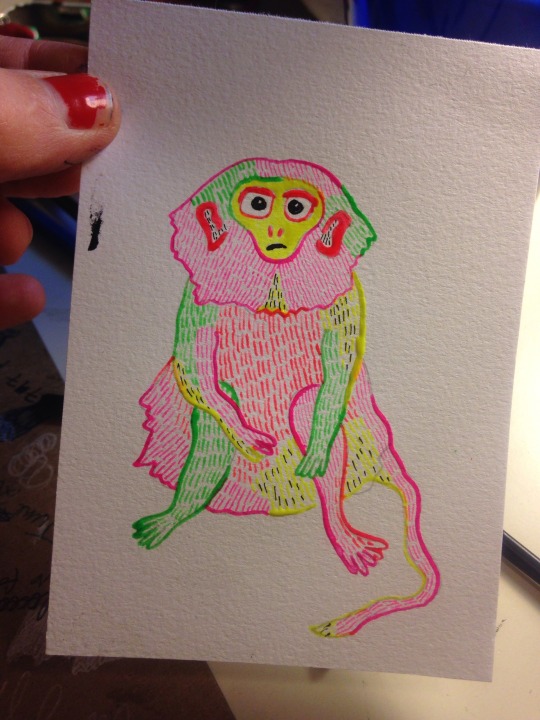#xenothrix
Explore tagged Tumblr posts
Photo
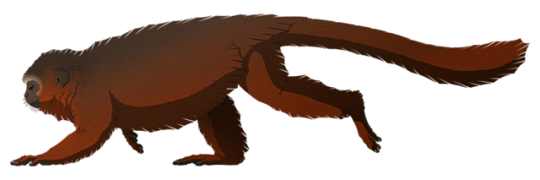
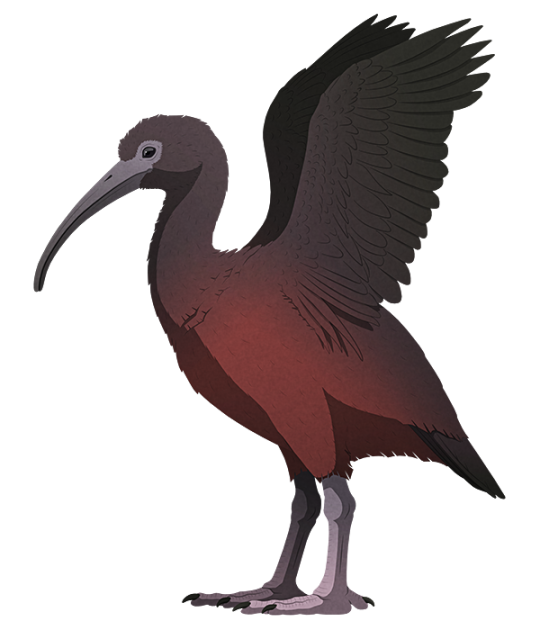
Island Weirdness #49 — Sloth-Monkeys & Fighting Ibises
Jamaica is the third largest island in the Caribbean, and much like Cuba it originated as part of a Late Cretaceous volcanic island arc. It began to subside during the Eocene and was completely submerged for a large portion of the Cenozoic, then was uplifted again in the early-to-mid Miocene, reaching close to its present-day size around 13 million years ago.
Few land mammals ever colonized the island prior to human influence, and most of the known remains are from rodents. But another group did make it onto Jamaica, and became something especially weird.
Xenothrix mcgregori is a primate only known from fragmentary remains, but what is known of its skeleton shows a unique combination of features for a New World monkey. It had a reduced number of teeth in its jaws, with enlarged molars, and oddly-shaped heavily-built leg bones that resemble those of slow quadrupedal climbers like lorises.
It was probably about 70cm long in total (2'4"), including the tail, and is thought to have lived a lot like a tree sloth, spending most of its time moving slowly around in the trees and possibly even feeding while hanging upside down.
Its anatomy was so ununsual that its evolutionary relationships were a mystery until ancient DNA was recovered from subfossil bones and confirmed it was actually a titi monkey very closely related to the genus Cheracebus. Its ancestors probably arrived on Jamaica in the late Miocene, around 11 million years ago, and it had some close relatives on a couple of other Caribbean islands — the terrestrial Paralouatta on Cuba, and Antillothrix and Insulacebus on Hispaniola — although they likely all independently colonized the Caribbean via different rafting events from South America.
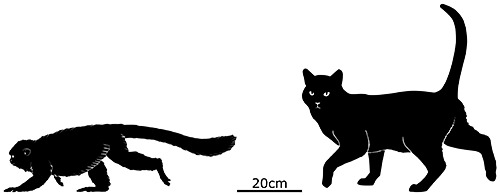
Another inhabitant of Jamaica was an equally strange bird.
Xenicibis xympithecus was one of only two lineages of ibis ever known to have become completely flightless (the other being Apteribis from Hawaii).
Around 60cm tall (2'), it had some of the most unique wings of any bird. The hollow bones were thickened, its forearm was proportionally short, and the hand was modified into a large heavy "club" — and blunt-force injuries on some of these birds' remains suggest that they used their wings as weapons when fighting, clobbering each other with powerful blows.
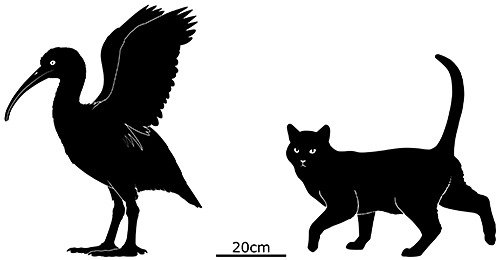
Radiocarbon dating suggests the Xenothrix monkeys survived well into the Holocene, until around 1100 CE. Since various groups of humans had been present on Jamaica since about 4000 BCE the sloth-monkeys must have coexisted with them for several millennia, and their extinction may have been caused by more of a "slow fuse" of gradual habitat destruction than direct exploitation.
Dating on Xenicibis' extinction is less precise, with the youngest known remains being somewhere between 10,000 and 2200 years old. It may have still been around when the earliest humans arrived, but unlike the native monkeys it seems like it didn't last long beyond that point.
#science illustration#island weirdness 2019#paleontology#paleoart#palaeoblr#xenothrix#xenotrichini#callicebinae#titi#platyrrhini#new world monkey#primate#mammal#xenicibis#threskiornithidae#ibis#pelecaniformes#bird#dinosaur#art#convergent evolution#jamaica#caribbean#holocene extinction#island weirdness 2: endemic boogaloo
173 notes
·
View notes
Text
Should we be troubled by the fact that, until efforts were made recently to reintroduce parrots to Martinique, there were no endemic species left on the island? How much should we grieve for the Cuban Red Macaw? Should we mourn the Caribbean monk seal? [...]
Hostages to the economic demands of metropolitan centers not always aware of the environmental damage caused by their policies [...], the islands of the Caribbean have experienced successive waves of ecological assault chronicled in fiction and nonfiction alike [...]. [I]n June 2008 the monk seal finally [officially] joined the growing list of victims of ecological changes unleashed by colonialism and postcolonial tourism development in the Caribbean basin. [...] The Caribbean is (alas!) one of the world’s hotspots [of biodiversity] [...] [w]ith around 7,000 species of plants and 160 bird species found nowhere else in the world [...]. The Caribbean region’s subordinate entry into global mercantilism in the sixteenth century continues to haunt us. [...] The history of fauna extinctions as recorded in the literature of the Caribbean region chronicles the impact of [...] “slow violence [...].“
---
Barbados, one of the earliest plantation settlements in the Caribbean, is perhaps the best example of the impact of habitat collapse in the region in the first centuries of the European conquest. Colonized by English Royalists [...], it was completely deforested in a little over twenty years as planters submitted nearly 80 percent of the landmass to sugar cultivation - a fate that the small colony would quickly share with neighboring islands. As Shawn Miller explains in An Environmental History of Latin America:
Scores of plants, mammals, reptiles, and birds were unique to each island, and an uncounted number of species, [...] without their forest habitats, disappeared forever [...]. On Barbados, a few deletions were noted: the palmito palm, the mastic tree, the wood pigeon, a few species of conures, the yellow-headed macaw, and one variety of hummingbird - all vanished. No monkey species survived sugar’s colonization, and of the 529 noncultivated species of plants found on Barbados today, only 11 percent are native to the island.
---
Throughout the Caribbean, deforestation to clear the land for sugar plantations led to the loss of a variety of unusual native rodents like the hutia and shrew-like insectivores, many of them ancient species that have now not been seen for centuries. The Martinican Amazon parrot became extinct due to habitat loss as the island was cleared for agriculture in the seventeenth century; it has not been recorded since 1722. In 1699, Pere Labat [...] described a large population of small parrots living on Guadalupe, named Arantiga labati [...], of which no specimens have been recorded since the mid-eighteenth century. Fifteen mammals have become extinct in Hispaniola [...] due to the severe deforestation of Haiti.
Jamaica was home to a monkey, the Xenothrix mcgregori, lost when its forest habitat was cut by European colonists. It died out in the 1750s. The Cuban Red Macaw was reasonably common around 1800 in Cuba. Human encroachment in its habitats increased dramatically in the early nineteenth century, when Cuba intensified its sugar production to meet the demand created by the collapse of the St. Domingue [Haiti] sugar mills after the Haitian Revolution. [...] The last one is believed to have been shot in 1864 at La Vega in the vicinity of the Cienaga de Zapata swamp [...]. Nine species of Antillean iguanas and snakes became extinct after Europeans introduced mongoose and rats to protect sugar cane [...]. In 2008, the Caribbean monk seal (Monachus tropicalis ...) - the only subtropical seal native to the Caribbean Sea and the Gulf of Mexico - was declared officially extinct [...].
---
The concern for the impact of biodiversity loss in writings about the Caribbean can be found in some of the earliest literary and proto-literary texts written about the region. [...] Aphra Behn, in her novel Oroonoko, published in 1688, already pondered what the increasingly intense clearing of the Caribbean forests would mean for the Indigenous peoples and animals relegated to the diminishing woods. Behn’s sojourn in Suriname in 1653 coincided with what has been called “The Great Clearing,” the period between 1650 and 1665, marked by devastating deforestation throughout the British and French Caribbean [...] particularly for refining the sugar. [...] At the dawn of the eighteenth century, Pere Labat [...] at a time of fast plantation development in Martinique and Guadalupe, writes of his concerns with the loss of biodiversity [...] derailed by colonial agricultural expansion [...].
---
All text above by: Lizabeth Paravisini-Gebert. “Extinctions: Chronicles of Vanishing Fauna in the Colonial and Postcolonial Caribbean”. The Oxford Handbook of Ecocriticism, 340-357. Edited by Greg Garrard. 2014. [Bold emphasis and some paragraph breaks/contractions added by me. Presented here for commentary, teaching, criticism purposes.]
260 notes
·
View notes
Text
How This Caribbean Island Got A Monkey Like No Other
Before European arrival, Jamaica, Cuba, and Hispaniola were home to several monkey species. The fossils of these lost primates of the Caribbean have puzzled zoologists, with conflicting theories of how they fit into the monkey family tree. Newly recovered DNA has shown the extinct Jamaican monkey Xenothrix mcgregori was closely related to South American Cheracebus, a genus of titi monkeys, but evolved dramatically once it got to the island.
Islands fast-track evolution. Island clusters like the Galapagos can lead to stunning diversity as lifeforms evolve in different directions in semi-isolation. However, few mammals made it to ocean archipelagos prior to humans providing transport. Consequently, we know little about how our fellow furred creatures respond to these environments.
This has made the Caribbean's monkeys, thought to have reached the islands by rafting on vegetation, just as their ancestors did between continents, a topic of particular interest. Xenothrix is a particularly intriguing example. We are used to monkeys being speedy creatures, but Xenothrix's body and teeth indicate it was a slow-moving tree-dweller, although unlike sloths it fed on fruit, not leaves.
Professor Samuel Turvey of the Zoological Society of London has extracted DNA from Xenothrix bones for the first time. In Proceedings of the National Academy of Sciences Turvey and co-authors report the DNA suggests Xenothrix's ancestors split from South American titi monkeys 11 million years ago, presumably around the time they arrived on Jamaica.
Xenothrix had confused zoologists previously because of features such as its small size, lack of a third molar, and leg bones like rodents. Further complicating the question of where to place it was its differences from other Caribbean monkeys, which were expected to be its nearest relatives.
However, Turvey and co-authors have concluded monkeys colonized the islands at least twice, with Xenothrix no more closely related to Caribbean monkeys from the earlier migration than it was to many mainland species. Upon arriving on territory with few competitors, the monkeys grabbed a variety of evolutionary niches and radically changed their body shapes to suit.
“This new understanding of the evolutionary history of Xenothrix shows that evolution can take unexpected paths when animals colonize islands and are exposed to new environments,” Tovey said in a statement. “However, the extinction of Xenothrix, which evolved on an island without any native mammal predators, highlights the great vulnerability of unique island biodiversity in the face of human impacts”
The animals of the Caribbean suffered many extinctions when humans arrived several thousand years ago, and again with European colonization. Between these two, the region has suffered the highest rate of post-glaciation mammalian extinction in the world. With specimens dating to just 900 years ago, it seems likely Xenothrix was a victim of the second wave.
A Xenothrix skull (top) compared with its nearest relative. Note the fewer teeth ZSL.
Original Article : HERE ; This post was curated & posted using : RealSpecific
=> *********************************************** Originally Published Here: How This Caribbean Island Got A Monkey Like No Other ************************************ =>
How This Caribbean Island Got A Monkey Like No Other was originally posted by Monthly Mashed 1
0 notes
Text
Mystery monkey: history of unique Xenothrix fossil revealed
Mystery monkey: history of unique Xenothrix fossil revealed https://ift.tt/eA8V8J November 13, 2018 at 02:10AMA now-extinct monkey from Jamaica had South American roots, according to new DNA evidence. from BBC News - World https://ift.tt/2T6QGv5 A now-extinct monkey from Jamaica had South American roots, according to new DNA evidence. November 12, 2018 at 02:03PM https://ift.tt/eA8V8J https://ift.tt/2T6QGv5 from Blogger https://ift.tt/2QDljGQ
0 notes
Text
Primates del Caribe: ADN antiguo revela historia de mono misterioso
Primates del Caribe: ADN antiguo revela historia de mono misterioso
<a href="https://3c1703fe8d.site.internapcdn.net/newman/gfx/news/hires/2018/primatesofth.jpg" title="El pariente cercano de Xenothrix , el mono titi rojo ( Callicebus cupreus ). Crédito: ZSL “>

Xenotrix Pariente cercano, el mono titi rojo ( Callicebus cupreus ). Crédito: ZSL
El análisis del ADN antiguo de un misterioso mono extinto llamado Xenothrix, que muestra…
View On WordPress
0 notes
Text
Mystery monkey: history of unique Xenothrix fossil revealed
Mystery monkey: history of unique Xenothrix fossil revealed
By Helen Briggs BBC News
A mysterious extinct monkey from Jamaica that is unlike any other in the fossil record has South American roots, according to new evidence.
DNA extracted from fossilised bones suggests the monkey first colonised the island 11 million years ago.
It had no predators there and it evolved strange features not seen in living monkeys today.
But the animal went extinct a few…
View On WordPress
0 notes
Link
A now-extinct monkey from Jamaica had South American roots, according to new DNA evidence. from BBC News - World https://ift.tt/2T6QGv5 via IFTTT
0 notes
Link
A now-extinct monkey from Jamaica had South American roots, according to new DNA evidence. from BBC News - World https://ift.tt/2T6QGv5 https://ift.tt/eA8V8J
0 notes
Link
3 notes
·
View notes
Link
BBC News - World https://ift.tt/2T6QGv5
0 notes
Link
A now-extinct monkey from Jamaica had South American roots, according to new DNA evidence. from BBC News - World https://ift.tt/2T6QGv5
0 notes
Text
Mystery monkey: history of unique Xenothrix fossil revealed
A now-extinct monkey from Jamaica had South American roots, according to new DNA evidence. from RSSMix.com Mix ID 8204426 https://ift.tt/2T6QGv5 via IFTTT
0 notes
Text
Mystery monkey: history of unique Xenothrix fossil revealed
A now-extinct monkey from Jamaica had South American roots, according to new DNA evidence. from BBC News - World https://bbc.in/2T3WWng from Blogger http://bit.ly/2JYcg0B https://ift.tt/2JUmf6Z
0 notes
